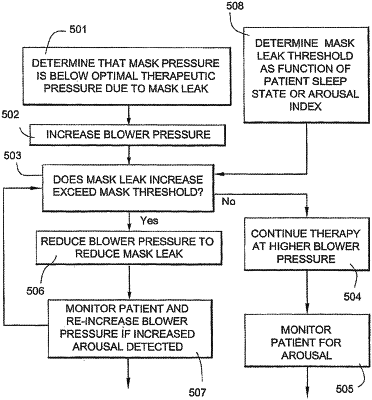| CPC A61M 16/0051 (2013.01) [A61M 16/0069 (2014.02); A61M 16/024 (2017.08); A61M 16/06 (2013.01); A61M 2016/0021 (2013.01); A61M 2016/0027 (2013.01); A61M 2016/0036 (2013.01); A61M 2205/15 (2013.01); A61M 2205/502 (2013.01); A61M 2205/52 (2013.01); A61M 2205/80 (2013.01)] | 20 Claims |

|
1. A method of acclimatizing a patient to provide continuous positive airway pressure (CPAP) therapy, including operating a device comprising a blower and a controller for treating sleep disordered breathing (SDB), wherein said device provides continuous positive airway pressure to the patient during sleep via a mask configured to provide a seal with respect to airways of the patient, the method comprising:
applying therapeutic pressure at a first therapeutic pressure during a treatment session;
monitoring a mask pressure within the mask during application of the first therapeutic pressure;
calculating a difference between the first therapeutic pressure and the mask pressure;
comparing the difference to a first threshold representing an acceptable level of leak;
generating a first signal in response to said comparing and indicative of performance of the seal;
in response to said first signal indicating a fault in the seal, increasing the applied therapeutic pressure above the first therapeutic pressure during the treatment session; and
based on a difference between the mask pressure at the applied first therapeutic pressure and the mask pressure at the applied increased therapeutic pressure being less than a second threshold, decreasing the applied therapeutic pressure to below the first therapeutic pressure during the treatment session in order to improve the seal of the mask against the patient's face.
|